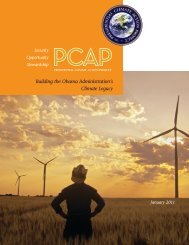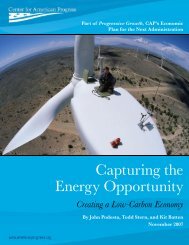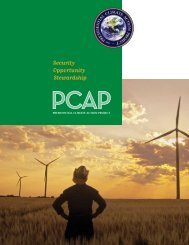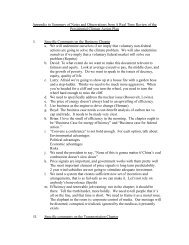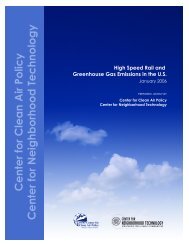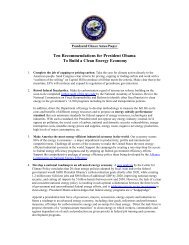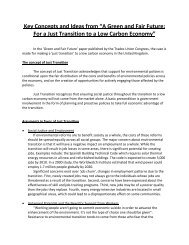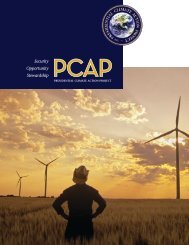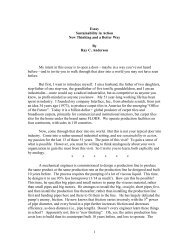(3) prepare and transmit to the Congress not later than June 1, 1993, and biennially thereafter, a comprehensivereport evaluating the full range of energy and environmental technologies necessary to(D) an evaluation of current programs (and recommendations for future programs) that develop and promote energyefficiency and sustainable use of indigenous renewable energy resources in foreign countries to reduce thegeneration of greenhouse gas.[This provisions mandates that the Secretary of Commerce shall develop a data base and information disseminationsystem that will provide information on the specific energy technology needs of foreign countries and the technicaland economic competitiveness of various renewable energy and energy efficiency products and technologies thatcan meet the energy needs of foreign countries.]42 U.S.C.A. § 13331Title 42. The Public Health and WelfareChapter 134. Energy PolicySubchapter VI. CoalPart A. Research, Development, Demonstration, and Commercial Application§ 13331. Coal research, development, demonstration, and commercial application programs(a) EstablishmentThe Secretary shall, in accordance with section [FN1] 13541 and 13542 of this title, conduct programs for research,development, demonstration, and commercial application on coal-based technologies. Such research, development,demonstration, and commercial application programs shall include the programs established under this part, andshall have the goals and objectives of--(3) achieving the control of sulfur oxides, oxides of nitrogen, air toxics, solid and liquid wastes, greenhouse gas, orother emissions resulting from coal use or conversion at levels of proficiency greater than or equal to applicablecurrently available commercial technology;42 U.S.C.A. § 13381Title 42. The Public Health and WelfareChapter 134. Energy PolicySubchapter VII. Global <strong>Climate</strong> change§ 13381. ReportNot later than 2 years after October 24, 1992, the Secretary shall submit a report to the Congress that includes anassessment of--(1) the feasibility and economic, energy, social, environmental, and competitive implications, including implicationsfor jobs, of stabilizing the generation of greenhouse gas in the United States by the year 2005;(4) the feasibility of reducing the generation of greenhouse gas;(6) the potential economic, energy, social, environmental, and competitive implications, including implications forjobs, of implementing the policies necessary to enable the United States to comply with any obligations under theUnited Nations Framework Convention on <strong>Climate</strong> change or subsequent international agreements.CEES Page | CC
42 U.S.C.A. § 13382§ 13382. Least-cost energy strategy(a) StrategyThe first National Energy Policy Plan (in this subchapter referred to as the “Plan”) under section 7321 of this titleprepared and required to be submitted by the President to Congress after February 1, 1993, and each subsequentsuch Plan, shall include a least-cost energy strategy prepared by the Secretary. In developing the least-cost energystrategy, the Secretary shall take into consideration the economic, energy, social, environmental, and competitivecosts and benefits, including costs and benefits for jobs, of his choices. Such strategy shall also take into account thereport required under section 13381 of this title and relevant Federal, State, and local requirements. Such strategyshall be designed to achieve to the maximum extent practicable and at least-cost to the Nation--(1) the energy production, utilization, and energy conservation priorities of subsection (d) of this section;(2) the stabilization and eventual reduction in the generation of greenhouse gas;(3) an increase in the efficiency of the Nation's total energy use by 30 percent over 1988 levels by the year 2010;(4) an increase in the percentage of energy derived from renewable resources by 75 percent over 1988 levels by theyear 2005; and(5) a reduction in the Nation's oil consumption from the 1990 level of approximately 40 percent of total energy useto 35 percent by the year 2005.d) PrioritiesThe least-cost energy strategy shall identify Federal priorities, including policies that—(1) implement standards for more efficient use of fossil fuels;(2) increase the energy efficiency of existing technologies;(3) encourage technologies, including clean coal technologies, that generate lower levels of greenhouse gases;(4) promote the use of renewable energy resources, including solar, geothermal, sustainable biomass, hydropower,and wind power;(5) affect the development and consumption of energy and energy efficiency resources and electricity through taxpolicy;(6) encourage investment in energy efficient equipment and technologies; and(7) encourage the development of energy technologies, such as advanced nuclear fission and nuclear fusion, thatproduce energy without greenhouse gases as a byproduct, and encourage the deployment of nuclear electricgenerating capacity.42 U.S.C.A. § 13383§ 13383. Director of <strong>Climate</strong> ProtectionWithin 6 months after October 24, 1992, the Secretary shall establish, within the Department of Energy, a Directorof <strong>Climate</strong> Protection (in this section referred to as the “Director”). The Director shall--(1) in the absence of the Secretary, serve as the Secretary's representative for interagency and multilateral policydiscussions of global climate change, including the activities of the Committee on Earth and EnvironmentalSciences as established by the Global change Research Act of 1990 (Public Law 101-606) [15 U.S.C.A. § 2921 etseq.] and the Policy Coordinating Committee Working Group on <strong>Climate</strong> change;(2) monitor, in cooperation with other Federal agencies, domestic and international policies for their effects on thegeneration of greenhouse gases; and(3) have the authority to participate in the planning activities of relevant Department of Energy programs.CEES Page | DD
- Page 1 and 2:
THE BOUNDARIES OF EXECUTIVE AUTHORI
- Page 4 and 5:
This page left intentionally blank.
- Page 6 and 7:
Proposal IndexPage NumberA Establis
- Page 8 and 9:
D-01 Direct the federal Climate Cha
- Page 10:
I. IntroductionThis report is a fol
- Page 16 and 17:
• The President shall not substit
- Page 18 and 19:
42, Chapter 77, Subchapter III expl
- Page 20 and 21:
In addition, it delegates to the Pr
- Page 22 and 23:
C. Presidential ProclamationsThere
- Page 24 and 25:
2. The developed country Parties an
- Page 26 and 27:
A. Establish National Energy and Ca
- Page 28 and 29:
the Nation, paying particular atten
- Page 30 and 31:
The President should establish the
- Page 32 and 33:
The President should establish the
- Page 34 and 35:
This proposal is framed in terms of
- Page 36 and 37:
partnership is working to reduce me
- Page 38 and 39:
Good candidate to implement by exec
- Page 40 and 41:
Executive Orders. There are 30 exec
- Page 42 and 43:
Congress annually a comprehensive r
- Page 44 and 45:
The Rural Utilities Services (RUS)
- Page 46 and 47:
through the energy policy, has some
- Page 48 and 49:
Direct the EPA to work with the Chi
- Page 50 and 51:
private members: E.O. 12216, the Pr
- Page 52 and 53:
next 20 years.” 181 From the publ
- Page 54 and 55:
Direct the EPA to immediately begin
- Page 56 and 57:
scientific judgment.” 199 Further
- Page 58 and 59:
Direct the EPA to immediately grant
- Page 60 and 61:
of climate change in California are
- Page 62 and 63:
Direct the EPA and DOE to collabora
- Page 64 and 65:
The ATA is a private entity, and as
- Page 66 and 67:
and Bioenergy, establishes an inter
- Page 68 and 69:
Authority over the Entities Subject
- Page 70 and 71:
Direct the DOT to reconvene the Cli
- Page 72 and 73:
Direct NASA to restore earth scienc
- Page 74 and 75:
Direct the Council on Environmental
- Page 76 and 77:
C. Improve Federal StewardshipDirec
- Page 78 and 79:
3. Background.OMB performs legislat
- Page 80 and 81:
There are numerous executive orders
- Page 82 and 83:
Federal Energy Management Executive
- Page 84 and 85:
1973; (3) E.O. 12845, Requiring Age
- Page 86 and 87:
This proposal is consistent with an
- Page 88 and 89:
4. GHG reduction goals to transport
- Page 90 and 91:
President, but the President “may
- Page 92 and 93:
Declare that it is the responsibili
- Page 94 and 95:
1. Statutory provisions that establ
- Page 96 and 97:
whenever feasible; and disposal or
- Page 98 and 99:
species is listed as a threatened s
- Page 100 and 101:
Determination of priorities which a
- Page 102 and 103:
3.2 Declaring that it is the respon
- Page 104 and 105:
Management, (June 3, 1999) includes
- Page 106 and 107:
economic, and other requirements of
- Page 108 and 109:
environment.” Based on the polici
- Page 110 and 111:
D. Protect American Taxpayers from
- Page 112 and 113:
special committees but are expressl
- Page 114 and 115: Direct the federal Climate Change S
- Page 116 and 117: The CCSP is an executive branch age
- Page 118 and 119: E. Mobilize the MarketplaceDirect t
- Page 120 and 121: pollutants. Further, courts give gr
- Page 122 and 123: Direct the Council on Environmental
- Page 124 and 125: methods, and data related to sustai
- Page 126 and 127: F. Build Public-Private Partnership
- Page 128 and 129: printed in the Federal Register and
- Page 130 and 131: that officer or employee. Advisory
- Page 132 and 133: A-06A-07B-01B-02B-03B-04B-05B-06B-0
- Page 134 and 135: C-02.7C-02.8C-02.9C-03C-03.1C-03.2C
- Page 136 and 137: Appendix AStatutes with Specific Te
- Page 138 and 139: (C) assess the potential for the de
- Page 140 and 141: 15 U.S.C.A. § 657hTitle 15. Commer
- Page 142 and 143: (5) Climate fluctuation and change
- Page 144 and 145: (4) global data collection, and mon
- Page 146 and 147: 15 U.S.C.A. § 2932§ 2932. Committ
- Page 148 and 149: implementation of any Federal actio
- Page 150 and 151: (2) Projects eligible for funding u
- Page 152 and 153: emissions associated with each type
- Page 154 and 155: 22 U.S.C.A. § 7902§ 7902. Reducti
- Page 156 and 157: (c) Performance reviews and reports
- Page 158 and 159: (3) Priority for integrated gasific
- Page 160 and 161: [It is the purpose of this chapter
- Page 162 and 163: (i) that no low greenhouse gas emit
- Page 166 and 167: 42 U.S.C.A. § 13384§ 13384. Asses
- Page 168 and 169: (i) Selection of projects(3) In sel
- Page 170 and 171: (1) In generalThe Secretary, in con
- Page 172 and 173: (b) GoalsThe program shall have the
- Page 174 and 175: Subchapter II. Energy Security thro
- Page 176 and 177: Subchapter IV. Energy Savings in Go
- Page 178 and 179: (B) to reduce emissions of covered
- Page 180 and 181: § 17334. Actions by overseas priva
- Page 182 and 183: (5) be committed to minimizing admi
- Page 184 and 185: Appendix BProclamations that Addres
- Page 186 and 187: 8) Proc. 7150, Nov. 20, 1998, World



